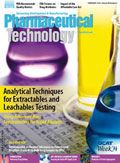Simple and affordable mass detection for the chromatographer
Simple and affordable mass detection for the chromatographer.
“Across numerous markets, including pharmaceuticals, people working in laboratories--whether in methods development, sample profiling, synthesis, or purification--have a real desire for access to mass-detection capabilities, but without the cost and complexity of a traditional mass spectrometer,” says Gary Harland, director for mass spectrometry product management at Waters Corporation. In most cases, access to immediate mass spectral data could significantly improve the efficiency of the analytical process. “What is really needed,” he continues,” is a mass detector that is complementary to their existing optical detection techniques and that can be easily and repeatedly used and maintained without extra work. In short, they want to obtain mass spectral data using a chromatographic-like detector.”
The new mass detector (ACQUITY QDa Detector) from Waters is based on the same ion physics as a conventional single quadrupole mass spectrometer, but is specially designed for a small footprint and to work synergistically with a variety of chromatographic separation systems, including liquid chromatography (LC), ultra high performance liquid chromatography (UPLC), and supercritical fluid chromatography (SFC), and conventional detection systems, such as UV-vis spectroscopy and photodiode array (PDA) systems, and do so at a cost closer to those detectors. The system covers the mass range typical for molecules that are separated and detected with LC/UV methods with acquisition speeds that match that of fast UHPLC systems.
Two key features, according to Harland, are its push-button operation and automatic calibration. “Once the system is turned on, it boots up within 30 seconds and is under vacuum within five minutes. Pressure is tested and it is ready to use within six-and-a-half minutes. For a cold start, the system also goes through automated calibrations, so it takes a little longer, but operators are still up and running within 20 minutes. At that point, the detector is ready to use in the same time as it takes a PDA to be ready.”
Waters engineered several innovations to achieve robust, high-quality mass detection at a reasonable price. Two examples include a single-piece, zero-adjustment probe capillary that not only eliminates all the optimization normally required but also minimizes dispersion and preserves high resolution chromatographic separation, and a new sample cone assembly featuring an inexpensive and disposable sample aperture that is easy to replace and only requires replacement about as often as the column is replaced, which saves both time and money while maintaining consistent performance, Harland explains.
“With the ability to obtain optical and electrospray ionization mass spectral data simultaneously, it is possible to identify compounds at low concentrations in complex mixtures, including co-eluting substances. As a result, the ACQUITY QDa Detector can be used for methods development, sample profiling, synthesis, and purification. We also believe it will be useful for the profiling of active pharmaceutical ingredients and related compounds, the determination of batch-to-batch variations, and the determination of extractables and leachables,” Harland concludes.

Pharmaceutical Tariffs Are Imminent: How Industry is Bracing for Impact
April 16th 2025On April 14, 2025, the Trump Administration launched a national security-driven investigation into pharmaceuticals, a move that will likely result in tariffs being placed on pharmaceutical drugs, ingredients, and other components that are imported from outside of the United States.
Drug Solutions Podcast: A Closer Look at mRNA in Oncology and Vaccines
April 30th 2024In this episode fo the Drug Solutions Podcast, etherna’s vice-president of Technology and Innovation, Stefaan De Koker, discusses the merits and challenges of using mRNA as the foundation for therapeutics in oncology as well as for vaccines.